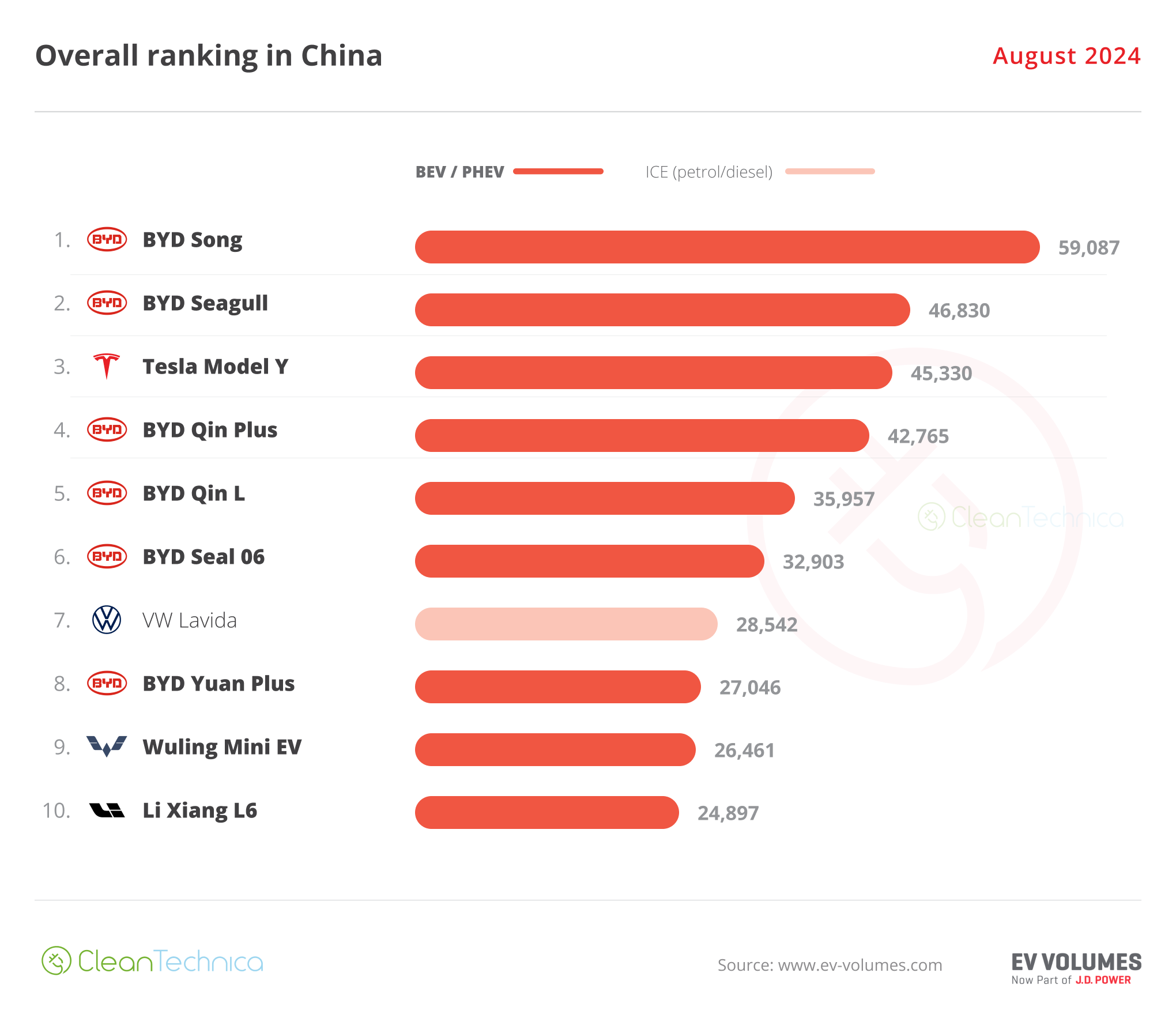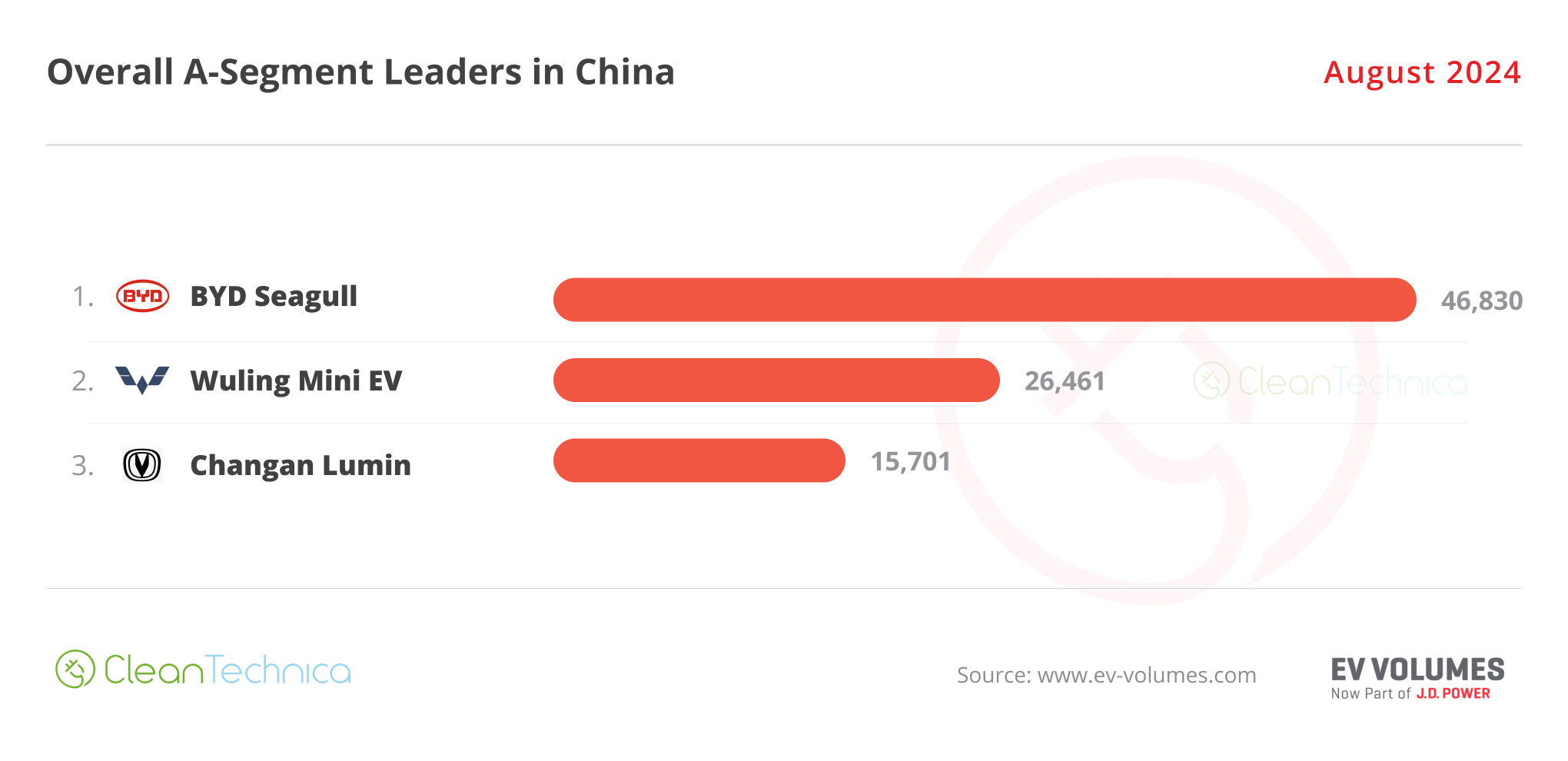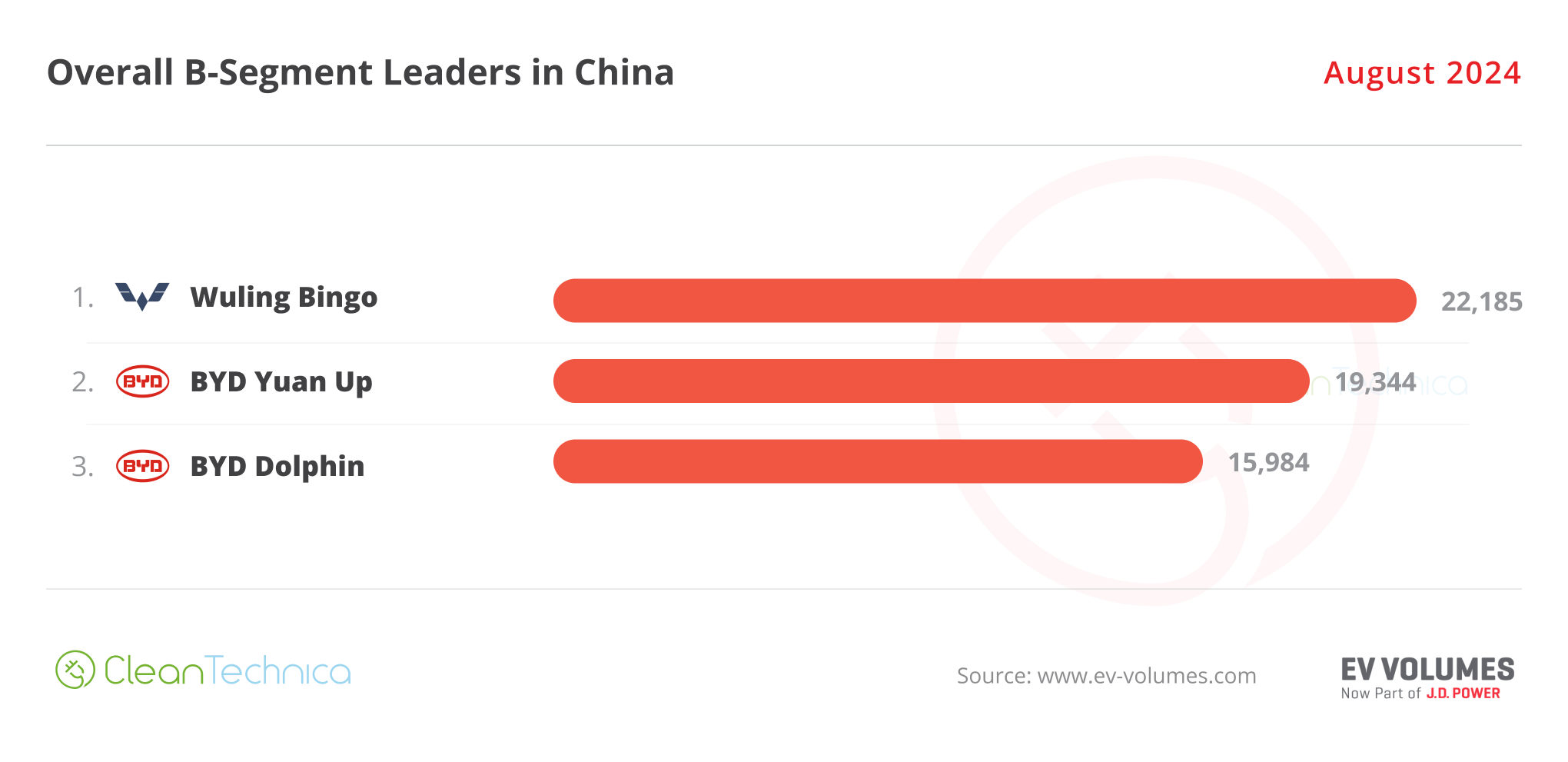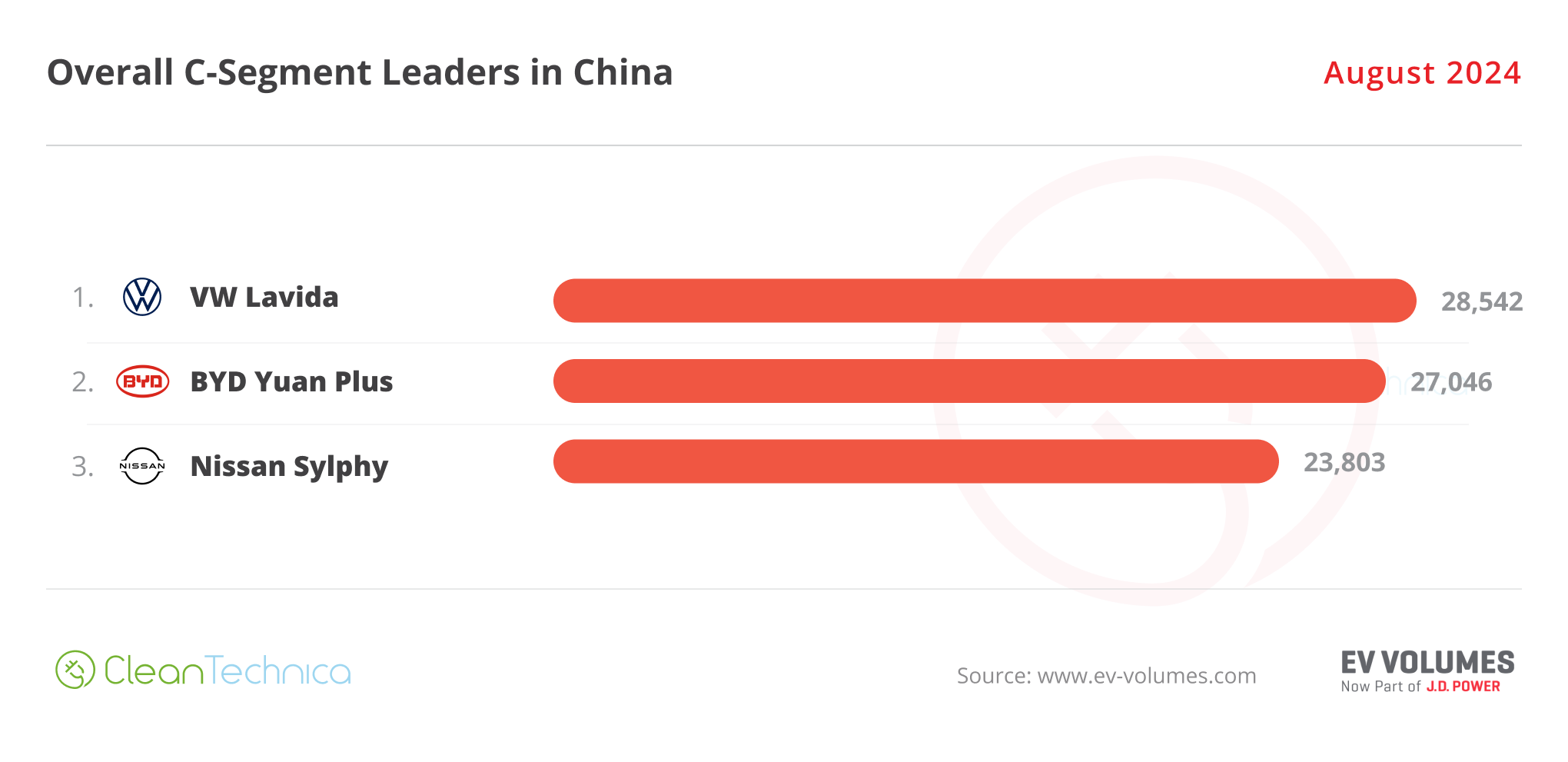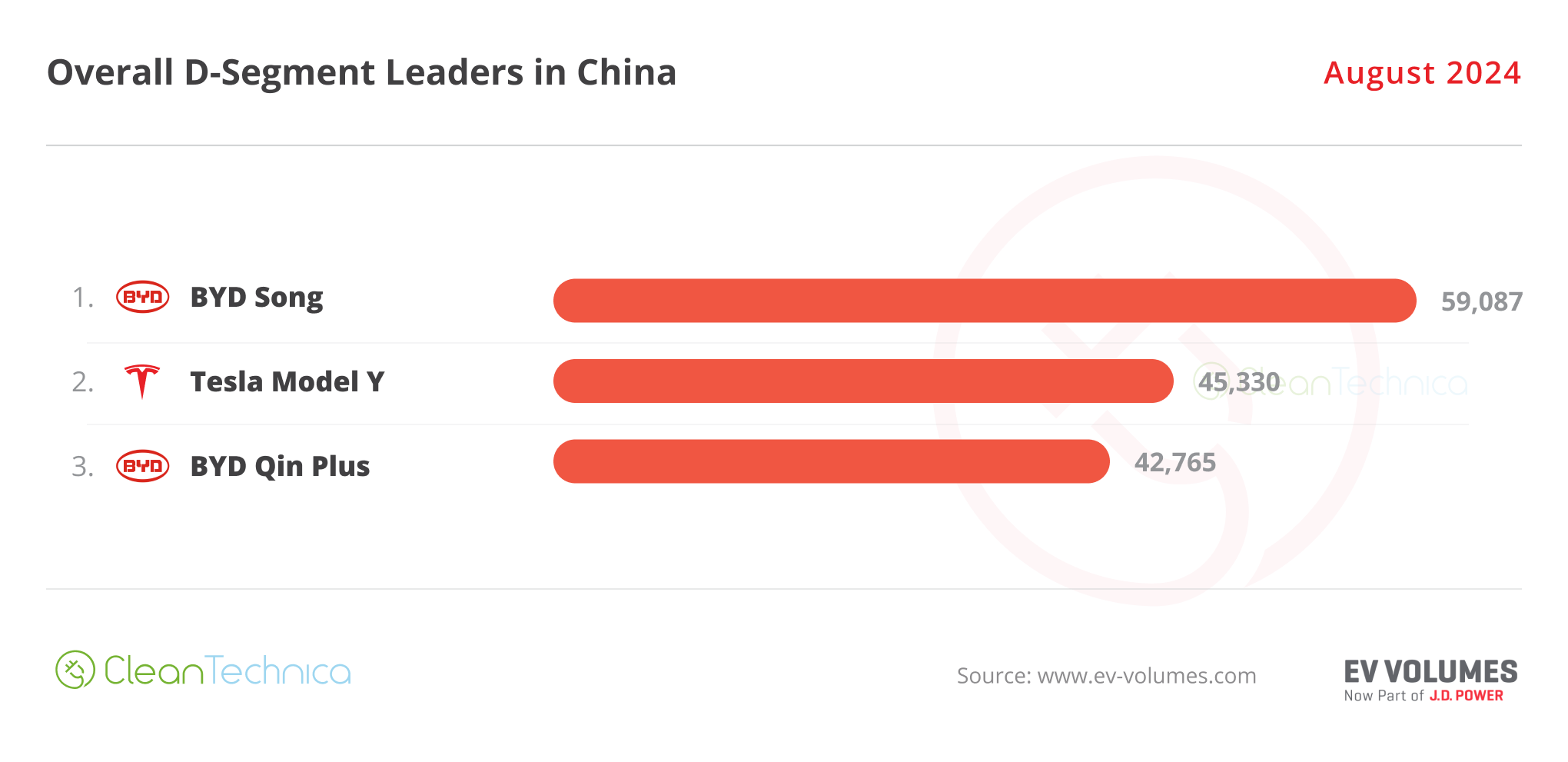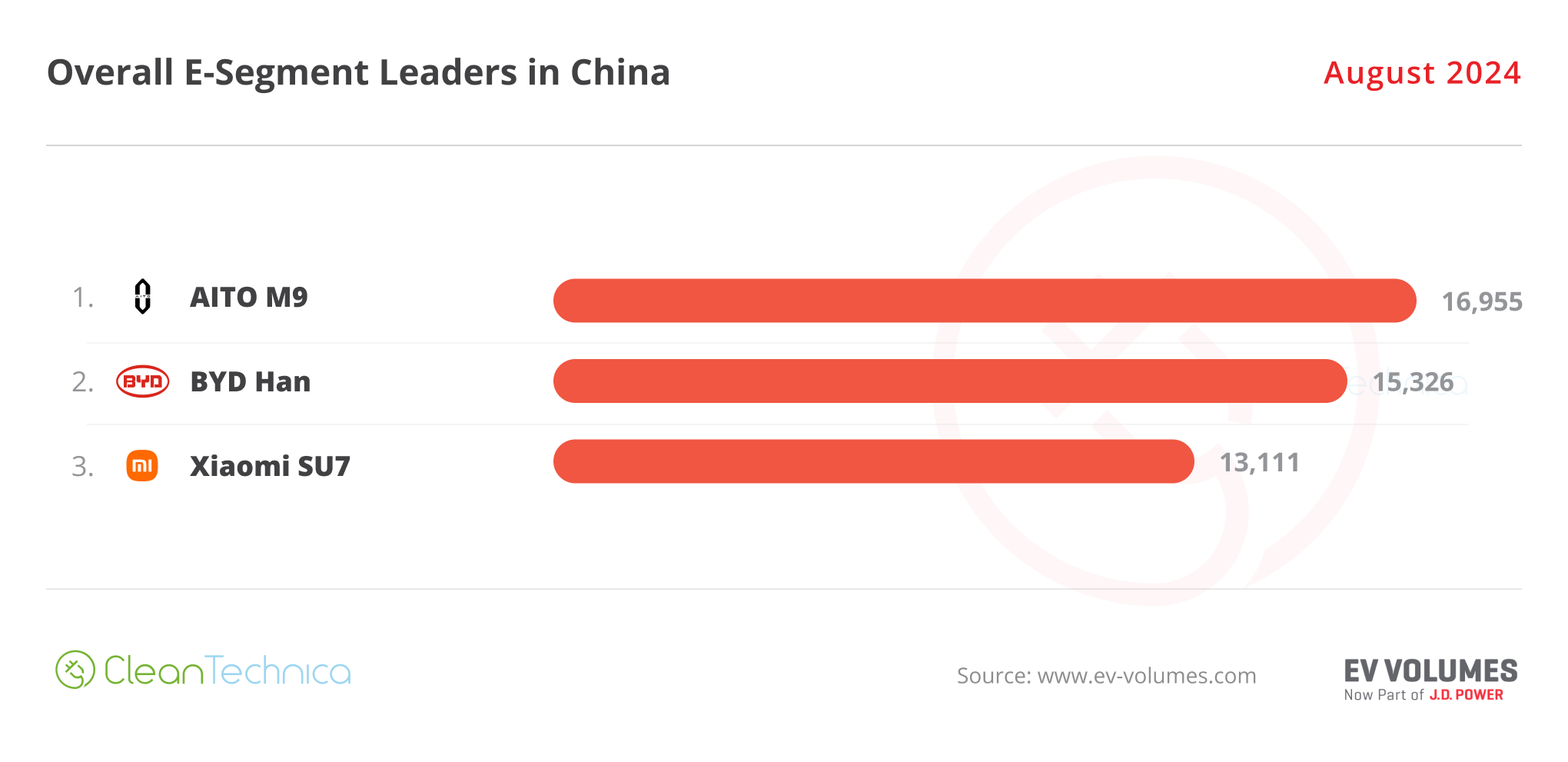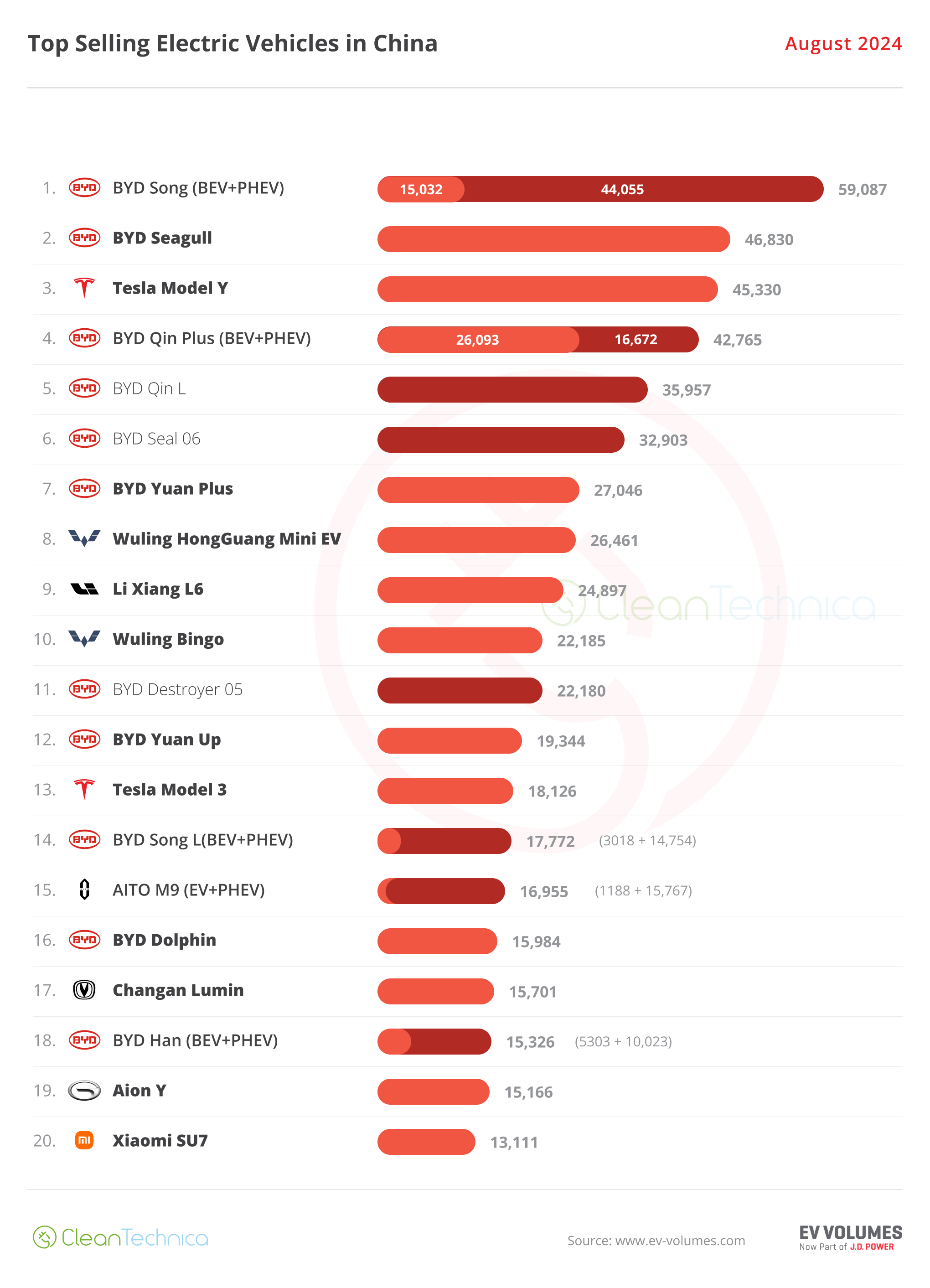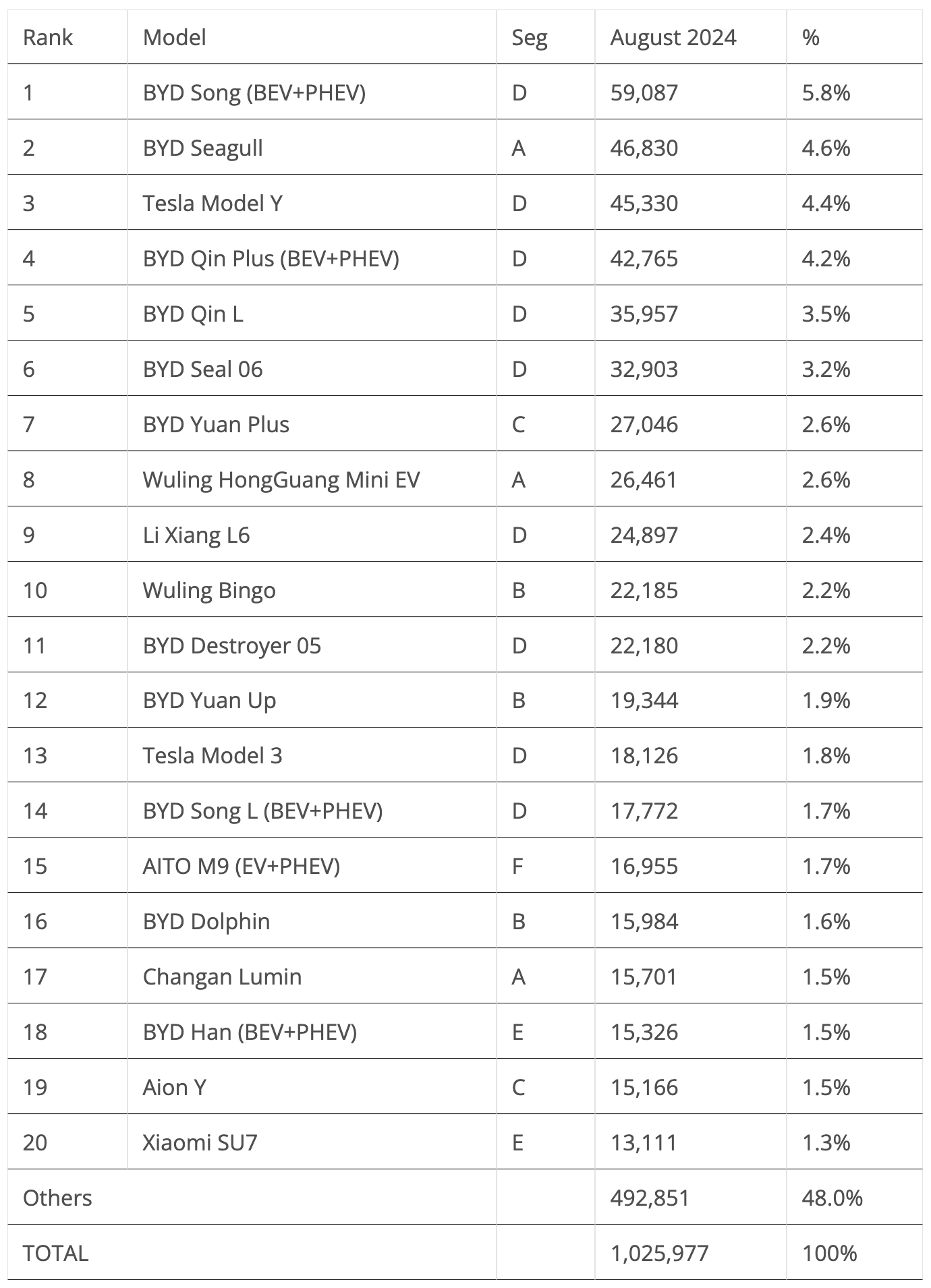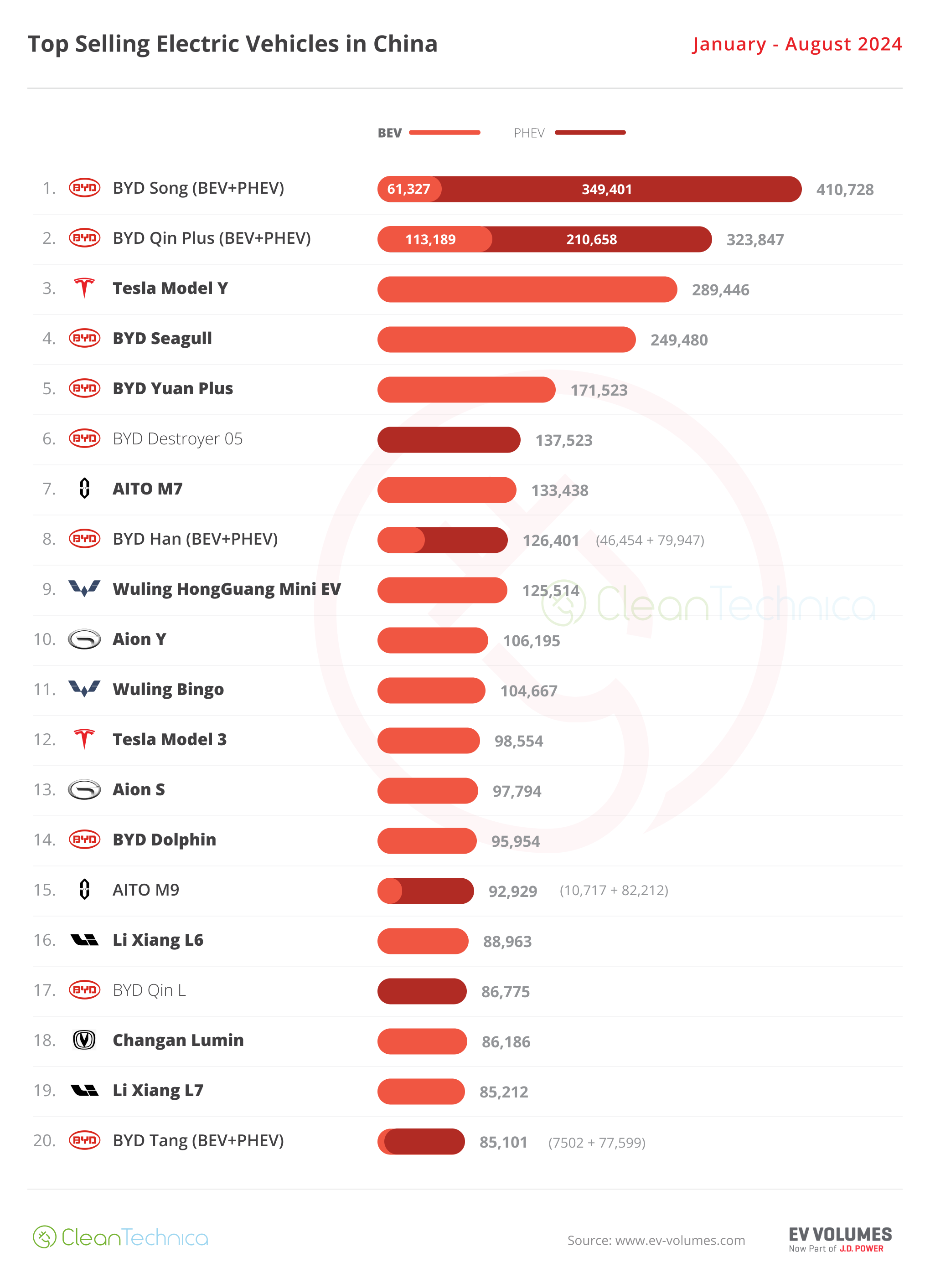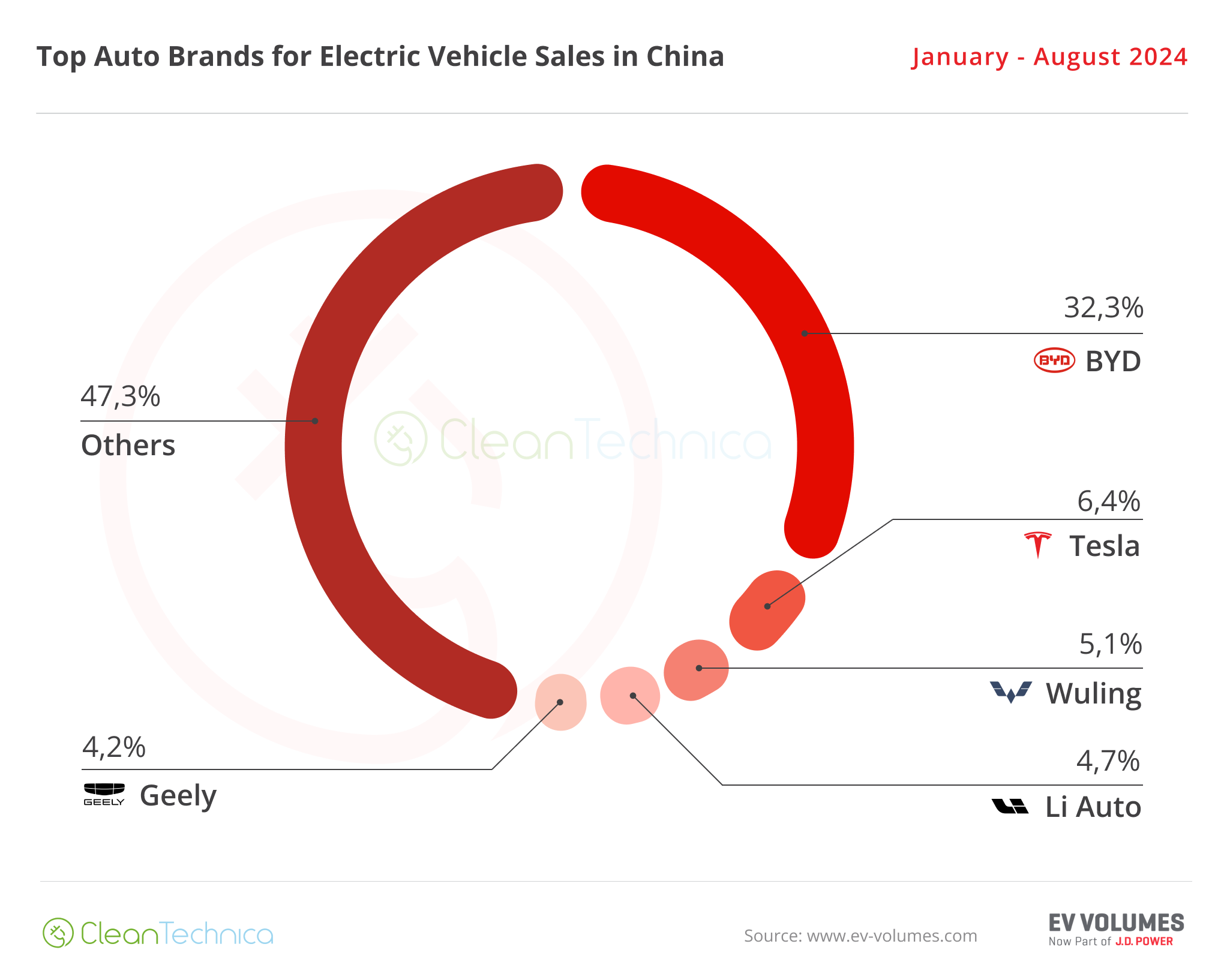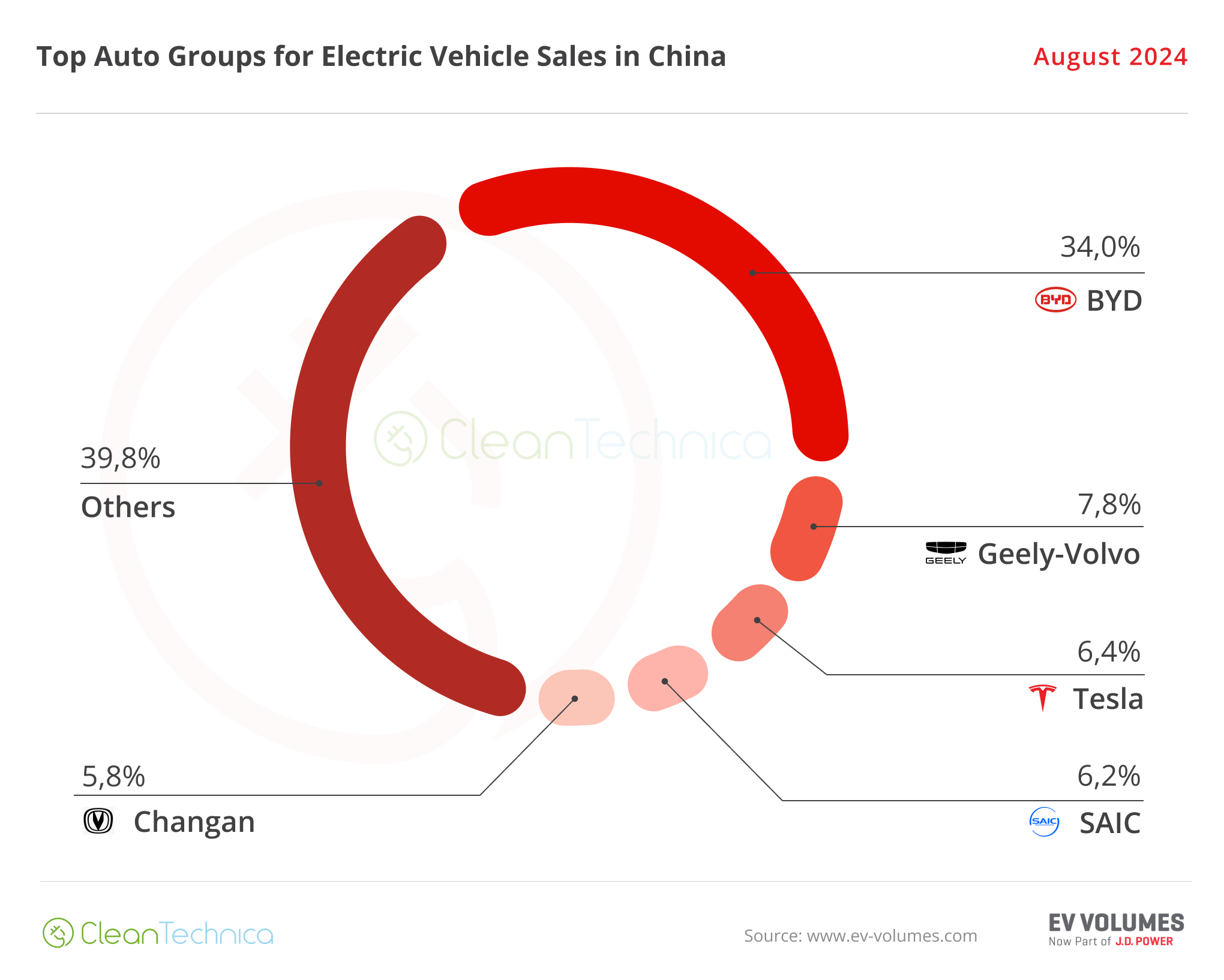Sign up for daily news updates from CleanTechnica on email. Or follow us on Google News!
Plugin vehicles are all the rage in the Chinese auto market, with plugins scoring a little more than 1 million sales (in a 1.9-million-unit overall market). That’s up 38% year over year (YoY), and the second best month ever, while the overall market is down 1% YoY.
Looking deeper at the numbers, growth basically came from the PHEV side — BEVs were up 19% in August, while PHEVs jumped 78% in the same period, to 442,000 units, which is a record month for the third straight time. Breaking down plugin sales by powertrain, BEVs had 57% of sales, or some 583,000 units, in line with the YTD numbers.
Considering the recent uptick in PHEVs, one must reflect on the reason for such events. Are long-range plugin hybrids the silver bullet to cut through the mainstream market?
With BEVs getting more than a quarter of the total market, the ones buying PHEVs aren’t the early adopters — those have already joined the BEV bandwagon. Rather, they are in the “early majority.” So, maybe PHEVs are indeed needed to convince that more conservative part of the population to go EV?
Anyway, back to sales. The year-to-date (YTD) tally is around 6.2 million units, a significant rise over the 4.7 million units in the same period of 2023.
Share-wise, August saw plugin vehicles hit a record 54% market share! Full electrics (BEVs) alone accounted for 31% of the country’s auto sales. This pulled the 2024 share to 46% (26% BEV), and with the market with plenty of room for growth, the year should end at around 50%.
Comparing this result with what was happening twelve months ago, the 2023 plugin share was 35% (24% BEV), which means that, while BEVs are experiencing moderate growth (26% vs 24%), the PHEV share is growing faster (20% vs 11%). At this pace, we should have the Chinese market fully electrified around 2030.
The overall top six were 100% plugins, with the Tesla Model Y being the best selling non-BYD model, in 3rd. The best selling ICE model was the Volkswagen Lavida, in 7th, with some 28,000 units sold. Highlighting the current shift in demand, there was only one ICE model in August’s overall top 10, the VW Lavida, and that one is seeing its sales fall significantly. The German sedan dropped 16% YoY.
In August, out of the nine plugin models in the overall top 10, six belong to BYD. The price cuts from the Shenzhen OEM are pressuring not only the ICE competition, which might be kicked out of the top 10 sometime in the second half of the year (September?), but also its plugin adversaries.
Looking at several size categories, all the vehicle segments have 100% PEV podiums with the exception of the C (compact) segment, which is the only category where ICE vehicles are still present. BYD’s Yuan Plus is representing the EV team in that category, while the upcoming (not so) compact hatchback, the Seal 06 GT, will surely help things for the EV side.
Amid BYD’s current market domination, it is interesting to see that the make is focusing more on the D segment/midsize category, and losing its grip on other categories, currently leading in just two vehicle categories, the aforementioned midzise category and the A segment/city car category.
In subcompacts (B segment), the Wuling Bingo is profiting from split sales in the BYD field — between the established Dolphin (15,984 units) and the rising Yuan Up (19,344 units). In the full size category, the recently introduced AITO M9 is beating the previous leader, the BYD Han, by over 1,000 units. Not bad for a XXL luxury SUV that starts at $66,000…. We should have a close race between these two in the following months. The surprise is Xiaomi placing its SU7 superstar in the 3rd position. That means that this category is 100% plugin — and it’s also a 100% domestic podium. So, this is another category that legacy OEMs can say bye bye to.
Best Selling EVs — One by One
Regarding last month’s best sellers table, the top 5 best selling models in the overall table exactly mirrored the ones in the EV table — which once again proves the merging process that we are witnessing between the two tables. Here’s more info and commentary on August’s top selling electric models:
#1 — BYD Song (BEV+PHEV)
BYD’s midsize SUV is the uncontested leader in the Chinese automotive market, and the Song retained the leadership position in August, keeping its rival, the Tesla Model Y, at a good distance. The midsize SUV scored 59,087 registrations, with the good news being that 15,032 units belonged to the BEV version (more than usual). Will the Song continue to rule in the Chinese automotive market? It will depend on the competition, especially the internal competition. In the near future, the Song will have to compete against tough internal competition, like the recently introduced Song L and Sea Lion 07 as well as the premium car-on-stilts Denza N7 (a car that sits somewhere between the Tesla Model Y and the Zeekr 001). All of these models want a piece of the pie. This is probably too much competition inside BYD’s midsize SUV portfolio for the Song to continue clocking 50,000 sales/month, a necessary threshold to continue leading the cutthroat Chinese auto market. But thanks to its competitive pricing, the Song is continuing its success story.
#2 — BYD Seagull
Things continue to go well for the hatchback model, with the small EV jumping into the second spot thanks to a record 46,830 registrations. With part of production now being diverted to export markets, it seems demand for the little Lambo is still growing in China. And with greater export potential than the regular Song, the perky EV could become the best selling BYD globally soon. With its attention now diverted to other geographies, like Latin America and Asia-Pacific (and Europe?), we could see the little hatchback ascend to the second position in the EV ranking in 2025, both globally and at home.
#3 — Tesla Model Y
Tesla’s star model got 45,330 registrations, down 11% YoY. That allowed it to land in 3rd in the overall ranking. Despite the sales drop, it was a good month for the US crossover, as it was its best month so far this year. The Model Y keeps Tesla relevant in the Chinese market — no small feat considering current market trends (the Tesla Model Y, together with its sibling Tesla Model 3, were the only foreign models in August’s top 20). Looking into the future, it will be interesting to see how both models will be affected (or not) by two upcoming self-declared anti-Tesla models, the NIO’s Onvo L60 and Xpeng’s Mona M03.
#4 — BYD Qin Plus (BEV+PHEV)
Along with the Song, the BYD Qin has been a bread and butter model for the Chinese automaker for a long time. The midsize sedan reached 42,765 registrations in August (a record 26,093 units belonged to the BEV version). This allowed it to be fourth in the overall market. Prices start at 80,000 CNY ($12,000), and demand still seems high. Despite the strong internal competition — just look at the new, fancier Qin L in 5th and the Seal 06 in 6th — the original midsize sedan from BYD is compensating for the loss in demand on the PHEV side (to the aforementioned two newer models) with an increase in sales on the BEV side, where at the moment it doesn’t suffer from strong internal competition. Expect the lower priced sedan to continue posting strong results at the cost of the competition, EV or ICE, all while keeping its external direct competitors — the Tesla Model 3, Wuling Starlight, and GAC Aion S — at a safe distance.
#5 — BYD Qin L
This new sedan is basically the 3rd generation of the BYD Qin, but because the second generation is still running strong, BYD added the suffix “L” to the new one to separate the two. In any case, it has landed with a bang, jumping into the top 5 in only its second full month on the market! In August, it repeated the feat, staying in 5th with a record 35,957 sales. And it has done this without hurting the sales of the regular Qin Plus too much. At this moment, BYD has a sort of Midas touch, transforming into gold (almost) everything it launches on the market, and it has launched a lot of metal recently…. Just to give an idea, if we were to add the July sales of the Qin Plus with the sales of the Qin L and the sales of the #6 Seal 06 (which is a sort of left-field trim line of the Qin L) and the #11 Destroyer 05 (the left-field trim line of the Qin Plus), we would get more than 133,000 registrations! That’s more than what the Tesla Model Y does globally….
BYD’s Domination in the Top 20
Looking at the rest of the top 10 list, there were six BYDs in total in the top 7 positions. And that’s not all….
… Looking at the rest of the table, we have five more BYDs, with the Destroyer 05 in #11, the Yuan Up in #12, the Song L in #14, the Dolphin in #16, and the Han in #19. There were thus eleven BYD representatives in the top 20. Amazingly, six of those eleven models all sit in the midsize category….
It feels like, to beat the Dragon Kings (Tesla Model Y/3), BYD raised a pack of smaller Dragons, which on their own might not be enough to beat the Kings, but when fighting together, they sure can leave them in the dust. (E Pluribus Unum and all that.…)
This kind of domination is happening at a time when BYD has several potential best selling models either ramping up (the Qin L, Seal 06, Yuan Up, and Song L all had record months) or landing. At this point, these models will likely cannibalize existing BYD models, but they will likely also steal sales from the competition.
One does start to wonder at what point BYD’s new-model-launch fever will start to get counterproductive…. How much is too much?
More Top 20 Notes
Outside the BYD Galaxy, the big surprise is the tiny Wuling Mini EV, which jumped into 8th with 26,461 units, the EV’s best result since February 2023. Highlighting Wuling’s good month, the bigger Bingo also had a year-best result, 22,185 sales.
The Tesla Model 3 ended the month in #13, with 18,126 sales, which is a 34% increase compared to the sedan’s performance a year ago. Are Chinese buyers finally warming up to the refreshed Tesla?
Another model on the rise is the AITO M9, which was in 15th with a near record 16,955 deliveries, 1,188 of them belonging to the BEV version. The flagship AITO is the make’s newest model, and probably the best from the make so far. Expect the 5.2-meter (205-inch) land yacht to become a frequent presence in the table and a serious contender for the XXL SUV category title.
 Chip in a few dollars a month to help support independent cleantech coverage that helps to accelerate the cleantech revolution!
Chip in a few dollars a month to help support independent cleantech coverage that helps to accelerate the cleantech revolution!
Outside the top 20, as usual, there was a lot to talk about, like Chery’s Fengyun T9 PHEV crossover, which delivered 8,856 sales in August, an impressive result for a model that is only in its 4th month on the market.
Geely saw its new Galaxy E5 crossover reach an impressive 12,227 units in its first full month, one of the best landings ever, so the E5 could be the long awaited star player from the Geely conglomerate. It could be able to not only secure a table presence, but also beat the category’s BYD competition. Still talking Geely, the Panda Mini registered 11,122 units, a new year best for the city car.
On the startup field, the highlight was the Leap Motor’s C16 full size SUV, which hit a record 8,032 sales, while its smaller siblings, the midsize C11 (6,878 sales) and the compact C10 (6,554 sales) also posted positive numbers, which means that the Hangzhou startup is currently one of the most promising EV companies in China.
Looking at foreign OEMs, the only highlight comes from the Volkswagen ID.3, which had a year-best score of 9,468 sales.
The 20 Best Selling Electric Vehicles in China — January–August 2024
Looking at the 2024 ranking, there’s nothing new in the top positions, with the podium bearers BYD Song, BYD Qin Plus, and Tesla Model Y safely in their positions.
We have to go down to the 16th position to see some action. The rising Li Xiang L6 has jumped three positions and is now 16th, with the midsize SUV likely jumping more spots in September, probably ending that month in 13th and finishing the year in the top half of the table.
One position down, we have the new BYD Qin L, which just joined the table, in #17, and will also jump several positions in the coming few months, likely finishing the year inside the top 10.
Changes in the Overall Brand Ranking
In August, the top three positions mirrored the 2023 full year ranking, with BYD on top followed by Volkswagen and Toyota. The dynamics are quite different, though. BYD (358,000 sales) grew 56% YoY, doubling the sales of #2 Volkswagen (171,000 sales), which was down by 12%, and #3 Toyota (135,000 sales), which fell by 13%. So, while the first place automaker is still rising fast (to infinity and beyond?), the other two are losing significant ground in a fast changing market.
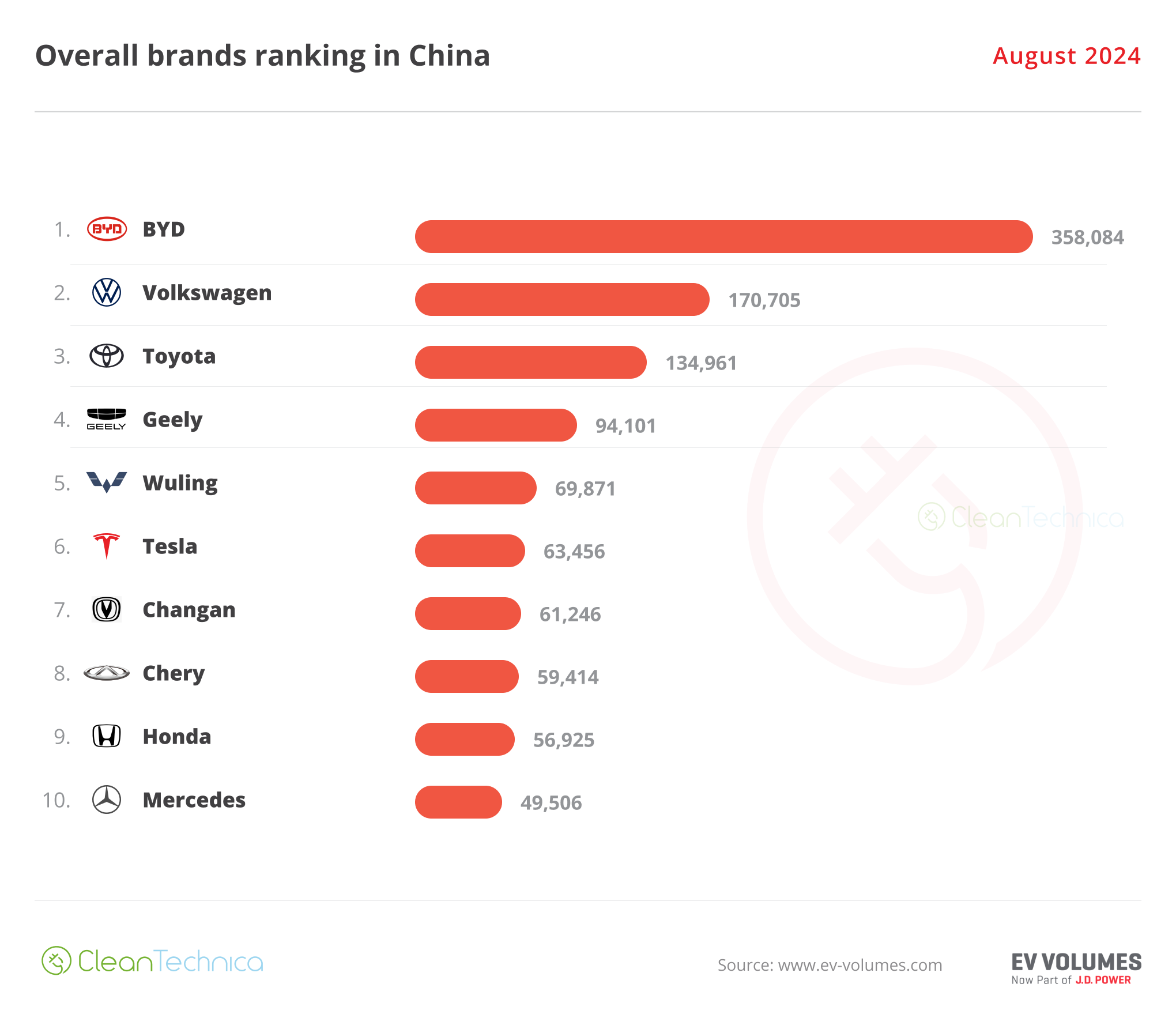 Confirming the domestic takeover, #4 Geely (94,000 sales) is firm in its position, while below it, Wuling (70,000 sales) jumped into the 5th position.
Confirming the domestic takeover, #4 Geely (94,000 sales) is firm in its position, while below it, Wuling (70,000 sales) jumped into the 5th position.
Honda, 4th in the full year of 2023, was only 9th in August, with a steep sales drop of 44% YoY. It’s like the ground is vanishing from beneath the Japanese carmaker.
Still, there are others worse than Honda, like Buick, which was down 60% in August; Cadillac, which dropped by 59%; and Chevrolet, which did even worse, cratering a worrying 84%! Basically, it looks like GM is being wiped out of China….
So, with these steep drops in sales happening, it won’t take long until certain legacy OEM related factories are shut down.
Looking at the top 10 as whole, there is also an interesting dynamic — all five foreign OEMs present there have seen their sales drop, while on the domestic side, only Changan has seen its sales drop. And even in the case of Changan, there is an explanation: the Changan brand is being left with the ICE business and old EV models, while the newer stuff is being sent into the more premium Deepal brand and the new Qyiuan brand, both NEV-only brands.
The numbers don’t lie — foreign makes are losing market share by the day in China, to the profit of the domestic ones. This is a seismic shift that promises to expand beyond Chinese borders in coming years.
Auto Brands Selling the Most Electric Vehicles in China
Looking at the auto brand ranking, there’s no major news. BYD (32.3%, up 0.9% from July) is firm in its leadership position, and there’s really no way to see this domination ending anytime soon.
Things get more interesting below, though. Tesla (6.4%, down from 6.5%) is comfortable in the runner-up spot, while Wuling profited from good results from its dynamic duo (Bingo and Mini EV) to increase its share (5.1% in August vs 4.6% in July) and surpass Li Auto (4.7%), which is benefitting from the popularity of its new L6 model to keep its status as the most successful startup.
Geely saw its Galaxy E5 & Panda Mini siblings shine, and has seen its share climb 0.2%, to 4.2% in August, allowing it to surpass AITO (4.1%, down from 4.4%) and reach the 5th position.
Aion (3.7%) is 7th, but without fresh best sellers coming in, do not expect it to join the race for 5th.
Auto Groups Selling the Most Electric Vehicles in China
Looking at OEMs/automotive groups/auto alliances, BYD Group is comfortably leading, with 34% share of the market. That increase in share is mostly thanks to the strong results of the namesake brand, as its daughter brands counted together actually lost share (0.3%, to be more precise). So, while the main brand goes from strength to strength, Denza, Fang Cheng Bao, and Yangwang are not doing their part when it comes to increasing the OEM’s profit margins. Hey, one can’t have everything, right?
At this moment, it seems BYD has its domestic market domination well assured, replicating what Tesla is doing in the USA.
Geely–Volvo is a distant runner-up, with 7.8% share, with the namesake’s good result in August being dragged down by sister brands having a slow month (ahem, Zeekr, ahem).
Tesla (6.4%) is firm in 3rd, while #4 SAIC (6.2%) hasn’t profited from Wuling’s good results, due to weak results elsewhere.
Shanghai Auto’s (SAIC’s) position in the Chinese market looks fragile, because apart from Wuling, the remaining brands are scattered in red, along with their JV foreign partners, GM and VW. For example, in August, MG dropped 22% and Maxus was down by 18%, just to name the two best known brands from the OEM. True, its new premium brand, IM Motors, jumped by 239% YoY, but with just 6,100 units sold in August, it barely moved the needle. While SAIC is one of those too big to fail companies, something needs to be done with it.
Back to the OEM table, #5 Changan lost share (now at 5.8%, down from 6.2% in July), but with #6 GAC (4.7%) still far behind, do not expect the Chongqing-based company to feel threatened for now.

Have a tip for CleanTechnica? Want to advertise? Want to suggest a guest for our CleanTech Talk podcast? Contact us here.
Latest CleanTechnica.TV Videos
CleanTechnica uses affiliate links. See our policy here.
CleanTechnica’s Comment Policy

